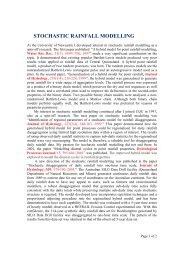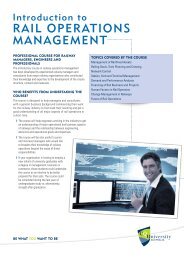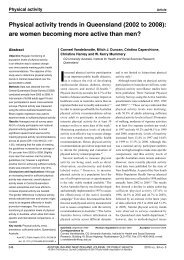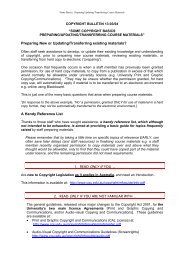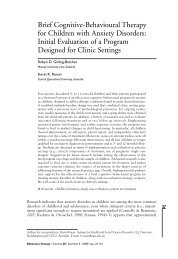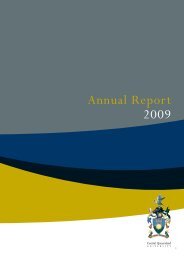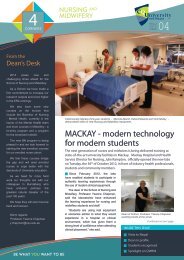12<strong>Central</strong> <strong>Queensland</strong> <strong>University</strong>and Controlled EntitiesNotes to the Financial Statementsfor the year ended 31 December 2012(b)Principles of Consolidation(i) SubsidiariesThe consolidated financial statements incorporate the assets and liabilities of all subsidiaries of <strong>Central</strong> <strong>Queensland</strong><strong>University</strong> (“parent entity”) as at 31 December 2012 and the results of all subsidiaries for the year then ended. <strong>Central</strong><strong>Queensland</strong> <strong>University</strong> and its subsidiaries together are referred to in these financial statements as the Group or theconsolidated entity.Subsidiaries are all those entities over which the Group has the power to govern the financial and operating policies,generally accompanying a shareholding of more than one-half of the voting rights. The existence and effect of potentialvoting rights that are currently exercisable or convertible are considered when assessing whether the Group controlsanother entity.Subsidiaries are fully consolidated from the date on which control is transferred to the Group. They are de-consolidatedfrom the date that control ceases.The acquisition method of accounting is used to account for the acquisition of subsidiaries by the Group.Intercompany transactions, balances and unrealised gains on transactions between group companies are eliminated.Unrealised losses are also eliminated unless the transaction provides evidence of the impairment of the asset transferred.Accounting policies of subsidiaries have been changed where necessary to ensure consistency with the policies adoptedby the Group.(ii) AssociatesAssociates are all entities over which the Group has significant influence but not control, generally accompanying ashareholding of between 20% and 50% of the voting rights. Investments in associates are accounted for in the parententity financial statements using the cost method and in the consolidated financial statements using the equity method ofaccounting, after initially being recognised at cost.The Group’s share of its associates’ post-acquisition profits or losses is recognised in the income statement, and its shareof post-acquisition movements in reserves is recognised in reserves. The cumulative post-acquisition movements areadjusted against the carrying amount of the investment. Dividends receivable from associates are recognised in the parententity’s income statement, while in the consolidated financial statements they reduce the carrying amount of theinvestment.When the Group’s share of losses in an associate equals or exceeds its interest in the associate, including any otherunsecured receivables, the Group does not recognise further losses, unless it has incurred obligations or made paymentson behalf of the associate.(iii) Business combinationsThe acquisition method shall be applied to account for each business combination, this does not include a combination ofentities or businesses under common control, the formation of a joint venture, or the acquisition of an asset or a group ofassets. The acquisition method requires identification of the acquirer, determining the acquisition date and recognising andmeasuring the identifiable assets acquired, liabilities assumed, goodwill gained, a gain from a bargain purchase and anynon-controlling interest in the acquiree that are present ownership interests and entitle their holders to a proportionateshare of the entity’s net assets in the event of liquidation. Identifiable assets acquired, liabilities assumed and any noncontrollinginterest in the acquiree shall be recognised separately from goodwill as of the acquisition date. Intangibleassets acquired in a business combination are recognised separately from goodwill if they are separable, but only togetherwith a related contract, identifiable asset or liability. Acquisition related costs are expensed in the periods in which they areincurred with the exception of costs to issue debt or equity securities, which are recognised in accordance with AASB132and AASB139.Identifiable assets acquired and liabilities and contingent liabilities assumed in a business combination are measuredinitially at their fair values at the acquisition date. Measurement of any non-controlling interest in the acquiree is at fairvalue or the present ownership instruments’ proportionate share in the recognised amounts of the acquiree’s identifiablenet assets. All other components of non-controlling interests shall be measured at their acquisition date fair values, unlessanother measurement basis is required by Australian Accounting Standards. Contingent liabilities assumed are recognisedas part of the acquisition if there is a present obligation arising from past events and the fair value can be reliablymeasured. The excess at the acquisition date of the aggregate of the consideration transferred, the amount of any noncontrollinginterest and any previously held equity interest in the acquiree, over the net amounts of identifiable assetsacquired and liabilities assumed is recognised as goodwill (refer to note 1(o)). If the cost of acquisition is less than the fairvalue of the identifiable net assets of the subsidiary acquired, the difference is recognised directly in the income statementof the acquirer, but only after a reassessment of the identification and measurement of the net assets acquired.
<strong>CQ<strong>University</strong></strong> ANNUAL REPORT 2012(c)<strong>Central</strong> <strong>Queensland</strong> <strong>University</strong>and Controlled EntitiesNotes to the Financial Statementsfor the year ended 31 December 2012Consideration transferred in a business combination shall be measured at fair value. Where the business combination isachieved in stages, the acquirer shall re-measure previously held equity interest in the acquiree at its acquisition date fairvalue and recognise the resulting gain or loss in profit or loss.Where a business combination is achieved in stages, previously held equity interests in the acquiree are re-measured tofair value at the acquisition date and any resulting gain or loss is recognised in profit or loss.Foreign currency translation(i) Functional and presentation currencyItems included in the financial statements of each of the Group’s entities are measured using the currency of the primaryeconomic environment in which the entity operates (“the functional currency”). The consolidated financial statements arepresented in Australian dollars, which is <strong>Central</strong> <strong>Queensland</strong> <strong>University</strong>’s functional currency.(ii) Transactions and balancesForeign currency transactions are translated into the functional currency using the exchange rates prevailing at the dates ofthe transactions. Foreign exchange gains and losses resulting from the settlement of such transactions and from thetranslation at year-end exchange rates of monetary assets and liabilities denominated in foreign currencies are recognisedin the income statement.Translation differences on non-monetary financial assets and liabilities are reported as part of the fair value gain or loss.Translation differences on non-monetary financial assets and liabilities, such as equities held at fair value through profitand loss, are recognised in profit or loss as part of the fair values gain or loss. Translation differences on non-monetaryfinancial assets are included in the foreign currency revaluation reserve in equity.(iii) Group companiesThe results and financial position of all the Group entities (none of which has the currency of a hyperinflationary economy)that have a functional currency different from the presentation currency are translated into the presentation currency asfollows:13ANNUAL FINANCIAL STATEMENTSassets and liabilities for each statement of financial position presented are translated at the closing rate at thedate of that statement of financial position;income and expenses for each income statement are translated at average exchange rates (unless this is not areasonable approximation of the cumulative effect of the rates prevailing on the transaction dates, in which caseincome and expenses are translated at the dates of the transactions); andall resulting exchange differences are recognised as a separate component of equity.(d)Revenue recognitionRevenue is measured at the fair value of the consideration received or receivable. Amounts disclosed as revenue are netof refunds, trade allowances and duties and taxes paid. Revenue is recognised for the major business activities as follows:(i) Government grants<strong>Central</strong> <strong>Queensland</strong> <strong>University</strong> treats operating grants received from Australian government entities as income in the yearof receipt. A provision is recognised where there is an obligation that the <strong>University</strong> will be required to return the funds tothe government in a future period.(ii) Investment incomeInvestment Income is recognised as it accrues based on the interest rate applicable to the asset and distributions received.(iii) Fees and chargesFees and charges are recognised as income in the year of receipt, except to the extent that fees and charges relate tocourses to be held in future periods. Such receipts (or portion thereof) are treated as income in advance in liabilities.Conversely, fees and charges relating to debtors are recognised as revenue in the year to which the prescribed courserelates.(iv) Sale of goodsSale of goods is recognised upon delivery of goods to the customer.





